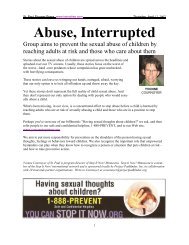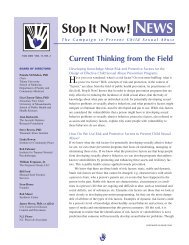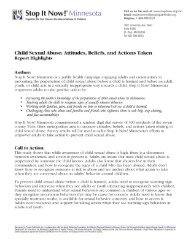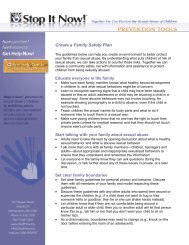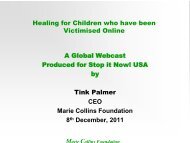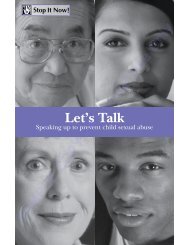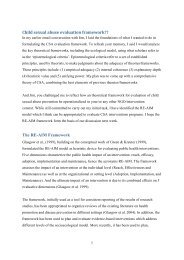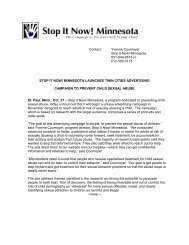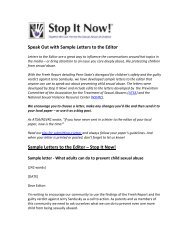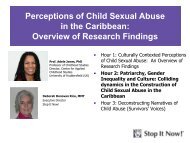Lessons Learned from Stop It Now! Community-Based Programs
Lessons Learned from Stop It Now! Community-Based Programs
Lessons Learned from Stop It Now! Community-Based Programs
You also want an ePaper? Increase the reach of your titles
YUMPU automatically turns print PDFs into web optimized ePapers that Google loves.
Child Sexual Abuse Prevention:<br />
<strong>Lessons</strong> <strong>Learned</strong> <strong>from</strong> <strong>Stop</strong> <strong>It</strong> <strong>Now</strong>!<br />
<strong>Community</strong>-based <strong>Programs</strong><br />
<strong>Stop</strong> <strong>It</strong> <strong>Now</strong>!
Our Mission<br />
<strong>Stop</strong> <strong>It</strong> <strong>Now</strong>! prevents the sexual abuse of children by mobilizing adults, families and<br />
communities to take actions that protect children before they are harmed.<br />
We provide support, information and resources so individuals and families can keep children safe and<br />
create healthier communities. Since 1992, we have identified, refined and shared effective ways for<br />
individuals and communities to act to prevent child sexual abuse before children are harmed and to<br />
get help for everyone involved.<br />
Our Vision<br />
Adults engage in respectful, caring behavior with children and other adults to create safe, stable and<br />
nurturing relationships for all children. Children grow up free of trauma <strong>from</strong> any form of violence<br />
including sexual abuse and exploitation.<br />
<strong>Programs</strong><br />
Help Services<br />
Provides direct help to individuals with questions or concerns about child sexual abuse.<br />
We offer help for specific situations through a confidential national Helpline<br />
(1.888.PREVENT), email, an interactive online tool (Online Help Center) and our new<br />
Ask <strong>Now</strong>! advice column.<br />
Prevention Advocacy<br />
Advocates for child sexual abuse to be addressed as a public health priority, encourages increased<br />
investment in a full range of prevention strategies, and provides evidence-based information to media,<br />
policymakers and advocacy groups.<br />
Prevention Education<br />
Develops, assesses and distributes educational materials through our website, publications, trainings,<br />
events and media campaigns. These help laypeople and professionals recognize harmful behavior and<br />
know how to take action – including where to get resources for action.<br />
Technical Assistance and Training<br />
Provides technical assistance and training to professionals, organizations, coalitions, and communitybased<br />
programs on strategies, policies and practices for preventing child sexual abuse. As part of<br />
strategic partnerships, we consult long term with groups that are adapting key elements of our adultresponsibility,<br />
community-based program model.<br />
Acknowledgements<br />
The insights summarized in this report would not be possible without the perseverance and support<br />
of nearly anyone who has had a hand in the work of <strong>Stop</strong> <strong>It</strong> <strong>Now</strong>! and its community-based<br />
programming.<br />
In particular, we would like to thank:<br />
• Our colleagues in the field of child sexual abuse prevention for sharing their time and perspective<br />
on <strong>Stop</strong> <strong>It</strong> <strong>Now</strong>!, our role in the field, and our contributions to prevention.<br />
• The staff and leadership of <strong>Stop</strong> <strong>It</strong> <strong>Now</strong>! community-based programs including:<br />
<strong>Stop</strong> <strong>It</strong> <strong>Now</strong>! Vermont and Safer Society Foundation and Kidsafe; <strong>Stop</strong> <strong>It</strong> <strong>Now</strong>!<br />
Philadelphia and the Joseph J. Peters Institute; <strong>Stop</strong> <strong>It</strong> <strong>Now</strong>! Minnesota<br />
and Project Pathfinder; <strong>Stop</strong> <strong>It</strong> <strong>Now</strong>! Georgia and Prevent Child Abuse Georgia;<br />
the <strong>Stop</strong> <strong>It</strong> <strong>Now</strong>! Massachusetts Helpline and Massachusetts Coalition for Sex<br />
Offender Management; <strong>Stop</strong> <strong>It</strong> <strong>Now</strong>! Virginia Helpline and the Virginia Department<br />
of Health; and <strong>Stop</strong> <strong>It</strong> <strong>Now</strong>! Wisconsin and the Children’s Hospital and Health<br />
System, Inc. and the Wisconsin Children’s Trust Fund.<br />
• Terry Amick for designing and conducting the interviews – and for summarizing the results.<br />
The preparation and printing of this report were partially supported by a generous grant <strong>from</strong><br />
the Oak Foundation. The opinions, findings, conclusions and recommendations expressed here<br />
are solely those of the authors and do not necessarily reflect the views of the Oak Foundation.<br />
© <strong>Stop</strong> <strong>It</strong> <strong>Now</strong>! 2012. All rights reserved.
<strong>Lessons</strong> <strong>Learned</strong> <strong>from</strong> <strong>Stop</strong> <strong>It</strong> <strong>Now</strong>!<br />
<strong>Community</strong>-based <strong>Programs</strong><br />
<strong>Stop</strong> <strong>It</strong> <strong>Now</strong>!<br />
Letter <strong>from</strong> the Executive Director<br />
Dear Friends,<br />
<strong>Stop</strong> <strong>It</strong> <strong>Now</strong>! was at a crossroads in 2008 as we considered how best to advance our work in the US and internationally.<br />
We knew it was important to document what we had learned <strong>from</strong> our 15 years working in communities,<br />
and to seek input on our impact and program model as we looked to the future. In keeping with our<br />
commitment to ongoing conversations, we reached out to staff <strong>from</strong> our community-based programs, as well as<br />
outside leaders in the field to identify the successes and challenges of using the <strong>Stop</strong> <strong>It</strong> <strong>Now</strong>! approach to prevent<br />
child sexual abuse at the community level. The information gleaned <strong>from</strong> these conversations informed the evolution<br />
of our program model.<br />
In reviewing their input, we realized respondents shared insights and lessons important not only to <strong>Stop</strong> <strong>It</strong> <strong>Now</strong>!<br />
but also to others wanting to work with communities on preventing the sexual abuse of children. For that reason,<br />
we are sharing their voices and input with you in this report.<br />
Since 2008, we have taken to heart these four lessons: <strong>Stop</strong> <strong>It</strong> <strong>Now</strong>! continues to provide a unique voice and<br />
point of view to the field of child sexual abuse prevention; to be more accessible to more people, we need to be more<br />
flexible about how we work with communities; our messages and materials have been embedded in and live on<br />
in the work of many organizations; and no one approach will prevent child sexual abuse so we need to deepen<br />
our collaborations with others working in this field.<br />
<strong>Stop</strong> <strong>It</strong> <strong>Now</strong>! community-based programs no longer exist as they did in 2008 as independent, self-sustaining<br />
programs. Our strategy of embedding child sexual abuse prevention programming into a variety of settings including<br />
sex offender treatment centers, a child abuse prevention chapter, and a state health department helped<br />
mitigate the impact of the economic downturn of 2008 and the loss of funding many programs experienced.<br />
Components of the model live on in five of the six states where pilot programs were implemented.<br />
We continue to work with communities and, in fact, reach many more communities both in the US and internationally.<br />
Our educational materials are widely used by organizations and by individuals. Our training and<br />
technical assistance responds to the need for cost-effective, adaptable tools to help communities prevent the sexual<br />
abuse of children. And we continue to provide direct help to individuals including expanding the online capacity<br />
of our Helpline to provide accurate information, practical tools, guidance and support.<br />
In 2012, <strong>Stop</strong> <strong>It</strong> <strong>Now</strong>! is celebrating our 20th anniversary. As a pioneer in creating a comprehensive approach<br />
to preventing the perpetration of child sexual abuse, we invite you to learn <strong>from</strong> our experiences and to join with<br />
us to keep children safe <strong>from</strong> sexual abuse. Please read and share this report. Start conversations in your community<br />
and join the ongoing conversation at <strong>Stop</strong><strong>It</strong><strong>Now</strong>.org.<br />
Because together, we can prevent the sexual abuse of children.<br />
Sincerely,<br />
Deborah Donovan Rice<br />
3
Executive Summary<br />
In 2008, <strong>Stop</strong> <strong>It</strong> <strong>Now</strong>! sought input on the impact of our 15 years working in communities with <strong>Stop</strong><br />
<strong>It</strong> <strong>Now</strong>! community-based programs. We hired a consultant to gather information <strong>from</strong> both community-based<br />
staff and other professionals working in the field of child sexual abuse prevention.<br />
These respondents identified the following outcomes and lessons:<br />
• The core work of <strong>Stop</strong> <strong>It</strong> <strong>Now</strong>! - including our messaging, educational materials, Help<br />
Services, and trainings - needs to be made more accessible to more people.<br />
• <strong>Stop</strong> <strong>It</strong> <strong>Now</strong>! needs to increase our online presence, through developing the website as a tool<br />
box and participating in social networking and other online activities.<br />
• <strong>Stop</strong> <strong>It</strong> <strong>Now</strong>! should continue its current communications and messaging, but also work on<br />
creating easier ways for people to talk about this issue.<br />
• There is a shared, ongoing commitment to <strong>Stop</strong> <strong>It</strong> <strong>Now</strong>! core values and programming, even<br />
in the face of daily program challenges of messaging, fundraising, evaluation and collaboration.<br />
• The <strong>Stop</strong> <strong>It</strong> <strong>Now</strong>! approach is compelling for its coordinated, community-based approach<br />
while, paradoxically, this comprehensive approach is difficult to adequately finance, evaluate<br />
and sustain.<br />
• To meet demand and interest, <strong>Stop</strong> <strong>It</strong> <strong>Now</strong>! needs to develop a flexible model that offers options<br />
for specific services and programs that could be consistently replicated and evaluated.<br />
4
A Model for <strong>Community</strong>-based Child Sexual Abuse Prevention<br />
From 1995 to 2010, <strong>Stop</strong> <strong>It</strong> <strong>Now</strong>! collaborated with local organizations to develop and adapt its<br />
innovative, community-based approach to preventing child sexual abuse. <strong>Stop</strong> <strong>It</strong> <strong>Now</strong>! communitybased<br />
programs were established in a variety of communities and locations in the US, as well as in<br />
the United Kingdom, Ireland and Australia. [See Appendix A for a list of community-based programs<br />
and sponsoring organizations.]<br />
Each <strong>Stop</strong> <strong>It</strong> <strong>Now</strong>! community-based program was sponsored by a local organization who raised<br />
independent funds, agreed to follow the <strong>Stop</strong> <strong>It</strong> <strong>Now</strong>! guiding principles and public health approach,<br />
and created local multi-disciplinary advisory committees. While all <strong>Stop</strong> <strong>It</strong> <strong>Now</strong>! community-based<br />
programs followed the same principles, they also adapted their specific activities to their<br />
location. The <strong>Stop</strong> <strong>It</strong> <strong>Now</strong>! <strong>Community</strong>-based Program Archives (www.stopitnow.org/communitybased-program-archives)<br />
has detailed descriptions of the history and activities of each communitybased<br />
program.<br />
In 2008, <strong>Stop</strong> <strong>It</strong> <strong>Now</strong>! sought input <strong>from</strong> former board members and staff, colleagues <strong>from</strong> other<br />
organizations, and staff <strong>from</strong> <strong>Stop</strong> <strong>It</strong> <strong>Now</strong>! community-based programs to systematically reflect on<br />
the outcomes, impacts and key lessons <strong>from</strong> this phase of community-based work. This report summarizes<br />
their input and documents some of the key lessons learned. [See Appendix B for details<br />
on survey methodology.]<br />
Impact of <strong>Stop</strong> <strong>It</strong> <strong>Now</strong>! on Child Sexual Abuse Prevention<br />
When asked about the impact of <strong>Stop</strong> <strong>It</strong> <strong>Now</strong>! on prevention, respondents noted the following<br />
impacts:<br />
• A pioneer voice in re-framing how the public understands and addresses child sexual abuse.<br />
• Helped open dialogue and discussion and has given the public a face to the issue in a nonthreatening<br />
way.<br />
• Played a profound role at the national, professional level.<br />
• Is responsible for focusing the issue on understanding perpetration and the need to create<br />
systems that directly reach and provide support in risk situations.<br />
• Has been instrumental in switching public focus on the issue of child sexual abuse <strong>from</strong><br />
intervention (i.e. criminal justice, etc.) to prevention.<br />
“<strong>Stop</strong> <strong>It</strong> <strong>Now</strong>! is just so unique. <strong>It</strong> has made a huge influence in<br />
the field. <strong>Now</strong>! has changed child sexual abuse prevention and<br />
education for everyone.””<br />
15
What <strong>Stop</strong> <strong>It</strong> <strong>Now</strong>! Provided to <strong>Community</strong>-based <strong>Programs</strong><br />
In working with community-based programs, <strong>Stop</strong> <strong>It</strong> <strong>Now</strong>! provided access to all of its resources<br />
including messaging, educational materials, the <strong>Stop</strong> <strong>It</strong> <strong>Now</strong>! Helpline, and the <strong>Stop</strong><strong>It</strong><strong>Now</strong>.org<br />
website. Sites also received extensive consultation in developing and adapting programming<br />
including assistance with conducting market research, developing presentations and trainings,<br />
media advocacy, and evaluation methodologies.<br />
Messaging<br />
Respondents viewed <strong>Stop</strong> <strong>It</strong> <strong>Now</strong>! messages as positive, proactive, focused on prevention and<br />
inclusive in addressing child sexual abuse <strong>from</strong> the viewpoint of all involved, including people<br />
at risk to sexually abuse children.<br />
Local community-based program staff found the following messages effective in their work in<br />
communities:<br />
Adult are responsible for prevention:<br />
The most prevalent <strong>Now</strong>! messages emphasize it can<br />
be unjust and ineffective to put the burden of preventing<br />
child sexual abuse on children. <strong>Stop</strong> <strong>It</strong> <strong>Now</strong>!<br />
recognizes that adults are in an advantaged position,<br />
having more power to take action to prevent abuse.<br />
“The message is to think about<br />
your own behavior.”<br />
Everyone has a role in prevention:<br />
This includes bystanders or non-offending adults<br />
as well as people who are at risk to or have sexually<br />
abused children. <strong>Stop</strong> <strong>It</strong> <strong>Now</strong>! is unique in offering a<br />
wide range of options for taking action. The Helpline<br />
offers guidance and action steps for all people facing<br />
personal situations.<br />
“This [is] not about making it<br />
easy for someone who has sexually<br />
abused a child, but about<br />
keeping kids safe.”<br />
One of a series of ads developed by <strong>Stop</strong> <strong>It</strong> <strong>Now</strong>! Philadelphia<br />
6
What <strong>Stop</strong> <strong>It</strong> <strong>Now</strong>! Provided to <strong>Community</strong>-based <strong>Programs</strong><br />
Prevent abuse before a child is<br />
harmed: Stakeholders emphasized the key message<br />
of preventing children <strong>from</strong> being harmed<br />
in the first place, rather than waiting to recognize<br />
when children have already been abused. Adults<br />
need to understand that prevention focuses on<br />
creating safe environments for children as well<br />
as on learning warning signs of risky situations or<br />
behaviors that may indicate someone is at risk to<br />
sexually abuse a child.<br />
Treatment can play a role in prevention:<br />
<strong>Stop</strong> <strong>It</strong> <strong>Now</strong>! educates adults about the<br />
benefits of treatment and its role in preventing<br />
sexually abusive behavior. For families or people<br />
who care for someone whose behavior concerns<br />
them, treatment also provides some hope and incentive<br />
to take action because help is available for<br />
their loved one.<br />
A preventable public health issue:<br />
That <strong>Stop</strong> <strong>It</strong> <strong>Now</strong>! works <strong>from</strong> a public health<br />
model of prevention was seen as a strength for<br />
messaging, particularly in shifting the emphasis<br />
away <strong>from</strong> viewing child sexual abuse as solely a<br />
criminal justice problem.<br />
Language matters: Stakeholders emphasized<br />
the important role of language in framing<br />
messages including consistently using language<br />
describing behavior (‘someone who has sexually<br />
abused a child’) as opposed to labeling (‘perpetrator,’<br />
‘predator,’ ‘abuser’). This language conveyed<br />
the belief that people can change their behavior.<br />
A family and community issue: The<br />
<strong>Stop</strong> <strong>It</strong> <strong>Now</strong>! message emphasizes the fact that<br />
most abuse is perpetrated by someone known to<br />
the child, often a family member.<br />
“An important message is<br />
that of learning warning<br />
signs of someone at risk<br />
to sexually abuse a child<br />
because if you wait to recognize<br />
a child who has<br />
been sexually abused, it’s<br />
too late—a child has been<br />
harmed.”<br />
“Accountability—recognize<br />
and change how we hold<br />
people accountable but not<br />
waiting until the accountability<br />
is for the harm because,<br />
by then, it is too late.<br />
This leaves children vulnerable.”<br />
“We needed to get off the<br />
stranger threat in child sexual<br />
abuse and focus more<br />
on families, friends and<br />
neighbors.”<br />
7
What <strong>Stop</strong> <strong>It</strong> <strong>Now</strong>! Provided to <strong>Community</strong>-based <strong>Programs</strong><br />
Educational Materials<br />
Local community-based programs benefited <strong>from</strong> extensive <strong>Stop</strong> <strong>It</strong> <strong>Now</strong>! educational materials,<br />
which they co-branded with local contact information. These materials helped educate the public by<br />
providing accurate information in an easy-to-understand format.<br />
Helpline<br />
Respondents viewed the <strong>Stop</strong> <strong>It</strong> <strong>Now</strong>! Helpline as providing excellent support<br />
to both program staff and the public. For persons with concerns or issues, the<br />
Helpline provided an opportunity to privately and anonymously seek information,<br />
ask questions and discuss options. <strong>Stop</strong> <strong>It</strong> <strong>Now</strong>! community-based programs provided<br />
the Helpline with lists of local resources so callers <strong>from</strong> their area received<br />
more targeted referrals for help with their concerns. Respondents reported that the Helpline gives<br />
many people facing personal situations a place to turn to examine concerns and find options for<br />
next steps to keep children safe.<br />
Website<br />
Respondents identified the excellent information at <strong>Stop</strong><strong>It</strong><strong>Now</strong>.org as invaluable. They recommended<br />
viewing the website as a toolbox where people searching for information about preventing child sexual<br />
abuse would find the tools they needed to act to protect children. They also felt that investing in developing<br />
the capacity of the website would be a way to reach more people with our prevention messages.<br />
Research<br />
Each <strong>Stop</strong> <strong>It</strong> <strong>Now</strong>! community-based program was asked to conduct local random digit dial telephone<br />
surveys to gather local community information for use in adapting the <strong>Stop</strong> <strong>It</strong> <strong>Now</strong>! approach<br />
to their specific service area. This survey data helped to make the issue local. For example,<br />
local phone surveys of adults often showed high rates of adults having experienced sexual<br />
abuse as children, along with low rates of children telling adults about abuse or having their cases<br />
reported to authorities. Using statistics like these <strong>from</strong> local surveys helped communicate the<br />
scope and urgency of the issue locally, and galvanized public support for adults to take action. For<br />
more information about this research, read “What Do US Adults Think about Child Sexual Abuse,<br />
http://www.stopitnow.org/rdd_survey_report.<br />
8
What <strong>Stop</strong> <strong>It</strong> <strong>Now</strong>! Provided to <strong>Community</strong>-based <strong>Programs</strong><br />
<strong>Community</strong> Dialogues<br />
Respondents specifically called out the <strong>Community</strong> Dialogue presentations as events that effectively<br />
put a face on the issue. Dialogues are facilitated discussions among pre-selected and trained<br />
panelists, including an adult who experienced sexual abuse as a child, an adult who sexually abused<br />
a child, family members, and therapists. Dialogues help the public understand child sexual abuse<br />
<strong>from</strong> multiple points of view and help to correct inaccurate understandings and perceptions.<br />
Evaluation<br />
Respondents emphasized the importance of <strong>Stop</strong> <strong>It</strong> <strong>Now</strong>! evaluation methods including:<br />
1) Process evaluation to track results of trainings, materials distribution, Helpline calls,<br />
and other activities.<br />
2) Telephone public opinion surveys of adults prior to and after program interventions.<br />
3) Focus groups with various constituencies for market research and materials review.<br />
4) Pre and post workshop and training evaluations.<br />
One respondent noted <strong>Stop</strong> <strong>It</strong> <strong>Now</strong>! has “cared about evaluation <strong>from</strong> the beginning.”<br />
Networking<br />
Respondents identified being part of a network of other <strong>Stop</strong> <strong>It</strong> <strong>Now</strong>! community-based programs<br />
as an important benefit. The network provided a vehicle for sharing ideas and resources. Because<br />
of the challenging nature of the work and the ground-breaking approach being implemented, respondents<br />
specifically appreciated the opportunity to receive needed support. Some also appreciated<br />
how <strong>Stop</strong> <strong>It</strong> <strong>Now</strong>! effectively wove the local programs together in a synergistic way.<br />
9
Adapting the <strong>Stop</strong> <strong>It</strong> <strong>Now</strong>! Approach to Local Communities<br />
In keeping with the <strong>Stop</strong> <strong>It</strong> <strong>Now</strong>!<br />
guiding principle of collaboration,<br />
local community-based programs<br />
worked collaboratively with<br />
law enforcement and other criminal<br />
justice agencies, treatment<br />
services, victim advocates, state<br />
agencies, private foundations, national<br />
organizations, child care<br />
licensors, adults with direct experience<br />
with sexual abuse and the<br />
public.<br />
<strong>Stop</strong> <strong>It</strong> <strong>Now</strong>! community-based programs worked closely with steering or advisory committees to<br />
adapt the <strong>Stop</strong> <strong>It</strong> <strong>Now</strong>! approach to their local community. Local staff reported they received widespread<br />
support and several cited the engagement and commitment of local stakeholders on their<br />
program advisory committees.<br />
There were two areas where community-based programs were most likely to adapt <strong>Stop</strong> <strong>It</strong> <strong>Now</strong>! offerings<br />
to their specific communities: training and social marketing campaigns.<br />
Training<br />
Many respondents identified <strong>Stop</strong> <strong>It</strong> <strong>Now</strong>! local trainings as an area of perceived success and promising<br />
practice. <strong>Programs</strong> developed and/or provided trainings including primary prevention training<br />
for parents and foster parents, child care licensors and providers, and professionals engaged<br />
with either children who had been sexually abused or people who had sexually abused children.<br />
Generally, local program training was well received and viewed as highly professional, with trainers<br />
reported to have a great reputation within the community and professional arena.<br />
<strong>Programs</strong> reported various ways they were able to multiply program reach through training of<br />
trainers. In one case, a partnership with child care licensors and the resulting train-the-trainers program<br />
was a notable success and was instrumental in expanding program reach and impact on state<br />
level policy. Another community-based program was able to use limited, local resources to develop<br />
a community level constituents training that has been highly successful.<br />
Research-based Social Marketing Campaigns<br />
Social marketing campaigns developed by community-based programs were seen as very successful<br />
by several respondents. One respondent noted how the advertising campaign helped to change<br />
the understanding of primary prevention of child sexual abuse in their community. Several noted<br />
the successful use of research for messaging—both through the public opinion (random digit dial)<br />
surveys and social marketing research for specific ad campaigns. Others noted the success of working<br />
with media to place educational articles.<br />
10
What Challenges Impacted <strong>Stop</strong> <strong>It</strong> <strong>Now</strong>! <strong>Community</strong>-based <strong>Programs</strong><br />
Funding<br />
All local programs received funds <strong>from</strong> a mix of sources, including government grants and contracts,<br />
private foundations, individual donors, and earned income. Two local programs had multiyear<br />
funding <strong>from</strong> the Centers for Disease Control and Prevention (CDC). One local communitybased<br />
program, with assistance <strong>from</strong> <strong>Stop</strong> <strong>It</strong> <strong>Now</strong>!, received three separate rounds of funding <strong>from</strong><br />
the Federal government. Beyond fundraising events and online donations, community-based programs<br />
also received funding <strong>from</strong> professional organizations such as the state chapters of the Association<br />
for the Treatment of Sexual Abusers, <strong>from</strong> private foundations (local, state and national),<br />
state Children’s Trust Funds, state agencies, and Federal grants (authorized by the Violence Against<br />
Women Act).<br />
Most community-based programs were able to access funding <strong>from</strong> various sources but, across<br />
the board, securing ongoing and sufficient funding was a challenge. The economic crisis of 2008<br />
added challenges to an already difficult funding environment.<br />
<strong>Stop</strong> <strong>It</strong> <strong>Now</strong>! Minnesota worked with partners to commemorate World Day for Prevention of<br />
Child Abuse<br />
11
Why Communities Chose the <strong>Stop</strong> <strong>It</strong> <strong>Now</strong>! Approach<br />
Although the first two community-based programs--Vermont and Philadelphia-- were approached<br />
by <strong>Stop</strong> <strong>It</strong> <strong>Now</strong>! and invited to become community-based <strong>Stop</strong> <strong>It</strong> <strong>Now</strong>! programs, by 1997 organizations<br />
interested in the <strong>Stop</strong> <strong>It</strong> <strong>Now</strong>! approach were coming to <strong>Stop</strong> <strong>It</strong> <strong>Now</strong>! asking how they could<br />
become <strong>Stop</strong> <strong>It</strong> <strong>Now</strong>! programs.<br />
Respondents cited these factors in choosing <strong>Stop</strong> <strong>It</strong> <strong>Now</strong>!:<br />
• The focus on primary prevention or prevention before children are harmed.<br />
• Commitment to adult responsibility and perpetration prevention.<br />
• Compatibility with the existing mission of host agencies.<br />
• A comprehensive program that did not need to be reinvented.<br />
• The multi-faceted approach that incorporates primary prevention and intervention, as well<br />
as compassion and accountability for people who have sexually abused.<br />
• Focus on adult bystander (i.e., non-offending adult) responsibility to prevent abuse.<br />
• The model is “grounded in science, theory and information...”<br />
• Communities didn’t have to “start <strong>from</strong> scratch” and could network with and learn <strong>from</strong><br />
other communities.<br />
• The local market research random telephone survey methodology.<br />
• CDC support for collaborative efforts for perpetration prevention.<br />
• The director of one of the host organizations stated it was simply “good for the soul” of the<br />
agency to be part of a prevention effort.<br />
Respondents also shared that the focus <strong>Stop</strong> <strong>It</strong> <strong>Now</strong>! put on people at risk to sexually abuse children<br />
was challenging and a “turn-off” for some of their partners and the general public. They also<br />
noted that it is difficult to encourage people to admit to and be accountable for abusive behavior<br />
or to encourage families to act on concerns about a loved one.<br />
Billboard targeting adults concerned about their own thoughts or behaviors developed<br />
for <strong>Stop</strong> <strong>It</strong> <strong>Now</strong>! Minnesota<br />
12
Benefits and Challenges to Adopting an Existing Program Model<br />
Stakeholders cited several advantages to adopting an existing program model. Specifically, they<br />
appreciated the:<br />
• Ability to learn <strong>from</strong> community-based programs who’ve already applied and adapted the<br />
model to their community.<br />
• Excellent public education materials that frame the issue well. These helped expand the<br />
breadth of what sponsoring organizations were doing and were often relied on extensively,<br />
especially during the start-up phase.<br />
• Technical assistance– especially for social marketing – and the framework for the telephone<br />
survey research.<br />
• Help with connecting community-based program staff to potential collaborators, especially<br />
for the advisory board.<br />
Stakeholders also acknowledged challenges in using and adapting an existing program model associated<br />
with a national brand including:<br />
• How to accommodate the <strong>Stop</strong> <strong>It</strong> <strong>Now</strong>! brand within their existing marketing and communication<br />
strategies, especially when many sponsoring organizations had well developed local<br />
brands.<br />
• How to balance the need to maintain a consistent <strong>Stop</strong> <strong>It</strong> <strong>Now</strong>! brand with the importance of<br />
tailoring the model to their local context. This created challenges around messaging and<br />
development of new materials, including issues around intellectual property.<br />
• How much to highlight that <strong>Stop</strong> <strong>It</strong> <strong>Now</strong>! is unique in including people who have or are at<br />
risk to sexually abuse children as a target audience when there were challenges to local support<br />
and understanding of this stance.<br />
Despite challenges, respondents noted <strong>Stop</strong> <strong>It</strong> <strong>Now</strong>! has the ability to adapt to the needs of various<br />
“consumers,” as evidenced by its growth and expansion with work outside the US.<br />
An ad targeting bystanders developED for the <strong>Stop</strong> <strong>It</strong> <strong>Now</strong>! Virginia Helpline<br />
13
Broadening the Impact of <strong>Stop</strong> <strong>It</strong> <strong>Now</strong>!<br />
In seeking input on our history of community-based work, <strong>Stop</strong> <strong>It</strong> <strong>Now</strong>! was also looking to the<br />
future and specifically to how our community-based work could evolve to meet the increasing demand<br />
for programming at the community level. Our comprehensive approach required extensive<br />
investment which made it difficult or impossible for many communities to join with us. We asked<br />
respondents to share with us their vision for our future work with communities.<br />
• Maintain core messages: On the whole, respondents stated <strong>Stop</strong> <strong>It</strong> <strong>Now</strong>! should continue its<br />
current communications and messaging, but also work on creating easier ways for people to<br />
talk about this issue. Respondents suggested staying focused on the core concepts of adult<br />
responsibility and preventing perpetration. They also urged continued use of strategies like<br />
storytelling to put a human face on the issue and break down stereotypes and myths.<br />
• Be creative about new ways to encourage conversations: Respondents also urged continuing<br />
to find creative ways to help people have conversations, such as “making analogies to how<br />
hard it is to talk about someone’s drinking, smoking, eating, or HIV risk behavior and keeping<br />
the focus on prevention and health-promoting behaviors.” They recommended continued<br />
message development and testing to increase effectiveness of communications and<br />
advance policy options. Online engagement – including developing the website as a toolbox<br />
and participating in social networking and other online activities – was mentioned repeatedly<br />
as a key aspect of ongoing communication.<br />
• Continue to work with communities: Respondents were clear about the need to stay grounded<br />
in work with local communities to inform national activities. However, they suggested<br />
developing a flexible model that offers options for specific services and programs that could<br />
be consistently replicated and evaluated. The Helpline is seen as a valued direct service.<br />
Increasing options for training of professionals and train-the-trainer formats were recommended<br />
going forward.<br />
• Deepen evaluation efforts: Respondents supported the need for more rigorous evaluation of<br />
the model and suggested aligning with researchers to implement this.<br />
• Continue policy advocacy: Respondents supported continuing the policy efforts and recommended<br />
reaching out to other professional fields to embed child sexual abuse prevention in<br />
closely related areas of work.<br />
Meeting of community-based program and national staff, June 2007.<br />
14
Conclusion<br />
Child sexual abuse has deep and long lasting impacts on children, families, communities and our<br />
whole society. <strong>It</strong> reverberates and impacts personal health, family relationships, community safety,<br />
and our priorities as a society. Preventing child sexual abuse requires efforts across this spectrum.<br />
<strong>Stop</strong> <strong>It</strong> <strong>Now</strong>!, through our work in communities, has demonstrated that: adults will act to prevent<br />
abuse if they have access to accurate information, practical tools, guidance and support; and communities<br />
will mobilize around prevention initiatives that address the complexities of abuse closer<br />
to home.<br />
Since 2008, <strong>Stop</strong> <strong>It</strong> <strong>Now</strong>! has implemented many of the recommendations on how our programming<br />
should evolve to meet the needs of more communities. We have greatly expanded the resources<br />
available online at <strong>Stop</strong><strong>It</strong><strong>Now</strong>.org. We have begun providing training through webinars<br />
that are accessible to people in communities across the globe. We are working increasingly through<br />
strategic partnerships with universities, national and local child abuse prevention groups, and national<br />
and international child protection, child’s rights and child helpline networks. Our commitment<br />
to collaborate across sectors with a wide range of partners whether at the local, state, national<br />
or international level allows us the greatest opportunity to see the tenets of the <strong>Stop</strong> <strong>It</strong> <strong>Now</strong>! model<br />
embedded and relied upon to help create a comprehensive approach to preventing all types of<br />
sexual abuse of children.<br />
Our community-based work lives on in the sponsoring organizations who hosted <strong>Stop</strong> <strong>It</strong> <strong>Now</strong>!<br />
community-based programs. And, with a more flexible model for engaging with local efforts, we<br />
are able to reach and influence many more communities. The evolution of the model relies on the<br />
circle of learning presented in this report. Moving forward, we will continue to learn and deepen<br />
our work by applying this knowledge and new experiences to improve the usefulness of our advice<br />
and guidance, our prevention tools and other services.<br />
15
Appendices<br />
Appendix A: <strong>Stop</strong> <strong>It</strong> <strong>Now</strong>! <strong>Community</strong>-based <strong>Programs</strong><br />
<strong>Stop</strong> <strong>It</strong> <strong>Now</strong>! Site Sponsoring Organization Date<br />
<strong>Stop</strong> <strong>It</strong> <strong>Now</strong>! Vermont<br />
1) Safer Society Foundation<br />
1995-2001<br />
2) Kidsafe<br />
<strong>Stop</strong> <strong>It</strong> <strong>Now</strong>! Philadelphia Joseph J. Peters Institute 1999-2009<br />
<strong>Stop</strong> <strong>It</strong> <strong>Now</strong>! Minnesota Project Pathfinder 2000-2009<br />
<strong>Stop</strong> <strong>It</strong> <strong>Now</strong>! Georgia Prevent Child Abuse Georgia 2003-2008<br />
<strong>Stop</strong> <strong>It</strong> <strong>Now</strong>! Massachusetts Massachusetts Coalition for Sex Offender<br />
2004-2005<br />
Helpline<br />
Management<br />
<strong>Stop</strong> <strong>It</strong> <strong>Now</strong>! Virginia Helpline Virginia Department of Health 2004-2009<br />
<strong>Stop</strong> <strong>It</strong> <strong>Now</strong>! Wisconsin<br />
Children’s Hospital and Health System, Inc.,<br />
2005-2007<br />
and the Wisconsin Children’s Trust Fund<br />
<strong>Stop</strong> <strong>It</strong> <strong>Now</strong>! UK & Ireland* The Lucy Faithfull Foundation 2000-present<br />
<strong>Stop</strong> <strong>It</strong> <strong>Now</strong>! Australia Phoenix House 2005-2006<br />
*<strong>Stop</strong> <strong>It</strong> <strong>Now</strong> UK & Ireland operates as a sister organization, functioning nationally in the United<br />
Kingdom and Ireland.<br />
Appendix B: Methodology<br />
Terry Amick, M.P.H., was hired as an outside consultant to design and complete the surveys/interviews,<br />
compile comments and report on the results. With <strong>Stop</strong> <strong>It</strong> <strong>Now</strong>!, a total of 29 potential respondents<br />
were identified. <strong>Stop</strong> <strong>It</strong> <strong>Now</strong>! leadership contacted each to introduce the consultant. All<br />
subsequent communication was made by the consultant, including an email and attached survey<br />
followed two weeks later by a reminder email sent only to non-responders. A total of 13 surveys/<br />
interviews were completed.<br />
Two similar versions of the survey were created. One was administered to local staff of <strong>Stop</strong> <strong>It</strong> <strong>Now</strong>!<br />
community-based programs and another survey was developed for other professionals knowledgeable<br />
about the work of <strong>Stop</strong> <strong>It</strong> <strong>Now</strong>!. Six community-based program staff and seven other professionals<br />
completed surveys or interviews. The consultant compiled the results for review by <strong>Stop</strong> <strong>It</strong><br />
<strong>Now</strong>! staff, who were given an opportunity to suggest revisions without altering content or verbatim<br />
comments.<br />
16
<strong>Stop</strong> <strong>It</strong> <strong>Now</strong>!® prevents the sexual abuse of children by mobilizing<br />
adults, families and communities to take actions that protect<br />
children before they are harmed.<br />
351 Pleasant Street, Suite B-319<br />
Northampton, MA 01060<br />
Phone: 413.587.3500<br />
Fax: 413.587.3505<br />
www.<strong>Stop</strong><strong>It</strong><strong>Now</strong>.org<br />
Visit www.stopitnow.org/lessons-learned-community-based-programs for copies of this report.



